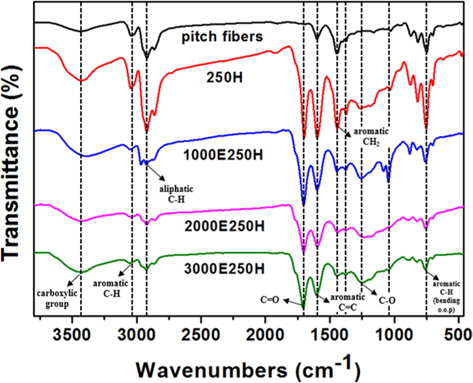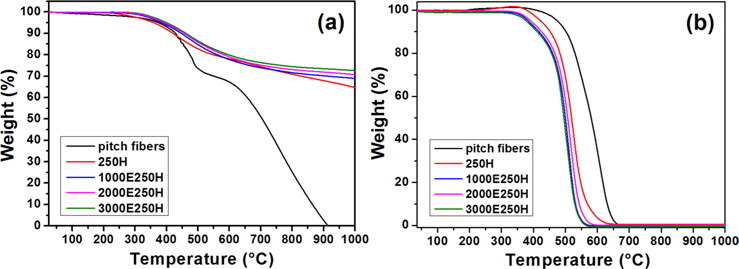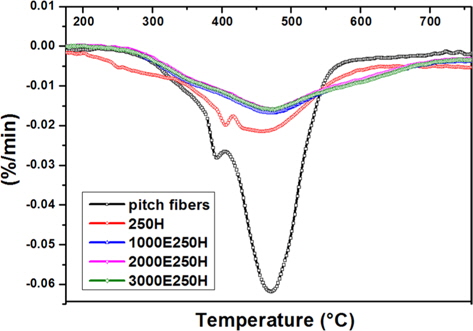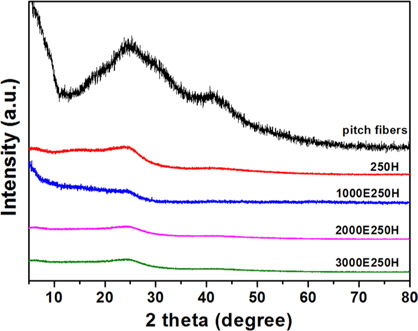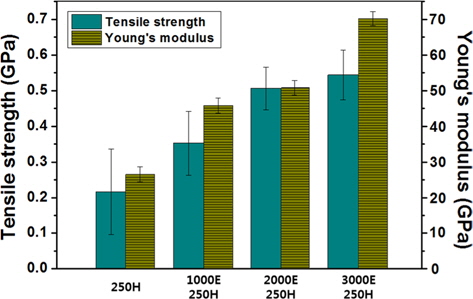



Carbon fibers (CFs) have recently attracted extensive attention as promising materials for a variety of applications, such as in automobiles, the aerospace industry, and construction, as well as in general engineering product markets [1,2]. Interest in CFs has been gradually growing due to their high strength, high stiffness, dimensional stability, and low coefficient of thermal expansion [3]. CFs having high and general performance are primarily produced from polyacrylonitrile (PAN) and pitches. To date, PAN-based CFs mostly have been applied in composites for aircrafts and automobiles. However, pitch-based CFs have been recently researched as an alternative because of their lower raw material costs and higher productivity compared to PAN-based CFs [4,5].
The stabilization process is an important step in the production of high performance CFs [6] because the stabilization determines the mechanical properties of the CFs, such as the Young’s modulus and tensile strength, after a high temperature heat-treatment process referred to as carbonization [7]. Stabilization provides the surface and interior of the fibers with oxygen functional groups to prevent melting of the fibers by maintaining a fibrous structure during carbonization. Stabilization is thus a crucial part of the CF preparation process when producing high and general performance CFs.
Electron beam (E-beam) irradiation has been extensively applied in polymer modification and is used to rapidly generate free radicals [8]. Shin et al. [9] recently reported the use of E-beam irradiation to stabilize PAN fibers in the preparation of PAN-based CFs. In addition, the molecular weight of the polymer increased greatly when free radical termination was minimized [10]. The stabilization of pitch-based CFs accompanying E-beam irradiation, however, has not been reported to date.
The present study introduced E-beam irradiation as a stabilization step in CF production to obtain general purpose CFs at a lower stabilization temperature and then investigated the effects of E-beam irradiation on the stabilization and mechanical properties of the final CF material. The CFs heat-stabilized at higher temperatures were not affected by the E-beam pretreatment. However, the CFs heat-stabilized at lower temperatures revealed that E-beam pretreatment significantly improved the tensile strength after carbonization as well as the stabilization index (SI) of CFs.
2.1. Preparation of pitch fibers
The pitch fibers used in this study were prepared from a reformed pitch precursor using a novel melt-spinning procedure. The pyrolyzed fuel oil (PFO) used in the reforming pitch was supplied by the GS Caltex Refinery Company in Korea and the obtained isotropic pitch had a softening point of 250℃. The pitch reforming procedure, which consisted of a subsequent distillation and thermal treatment, has been previously described [11,12]. In the melt-spinning method, a metal-syringe apparatus with a 10 g sample capacity was used to extrude the melted pitch through a mono-hole spinneret with a diameter of 0.1 mm. The following melt-spinning conditions were maintained throughout the process: a tip-to-collector distance of 20 cm and a collector speed of 1600 rpm. The spinning temperature and extrusion pressure of the pitch for melt-spinning were 300℃ and 2 bar, respectively. The diameter of the obtained pitch fibers was approximately 17-20 μm.
2.2. Stabilization and carbonization procedure
The as-spun fibers were stabilized using E-beam irradiation and heat to investigate the effect of the E-beam irradiation on the fiber stabilization. First, the as-spun pitch fibers were subjected to E-beam irradiation at an electron accelerating voltage of 1.14 MeV and current of 15.2 mA. The absorbed doses of the E-beam were 1000, 2000, and 3000 kGy. During the E-beam irradiation, the irradiation was paused at 500 kGy increments of absorbed dose to prevent the fibers from melting and sticking. Heat-stabilization was subsequently conducted under an air atmosphere in a forced convection oven. The air (zero air, 20.8% O2+N2 balance, Special Gas, Korea) flow rate was 500 cc/min. The pitch fibers were heattreated at a heating rate of 1℃/min and then held at 250℃ for 2 h. A sample of pitch fibers only subjected to heat stabilization was also prepared at 250℃ for 2 h as a comparison group. After the stabilization, the fibers were carbonized at 1000℃ for 1 h under a nitrogen atmosphere at a heating rate of 5℃/min in an electric furnace. The carbonized fibers were allowed to naturally cool to room temperature. The prepared samples were labeled according to the stabilization conditions as 250H, 1000E250H, 2000E250H, and 3000E250H, where H and E refer to heat-treatment and E-beam irradiation, respectively.
Elemental analyses of the pitch fibers and stabilized fibers were performed by using an elemental analyzer (EA 1112, Thermo Fisher Scientific, USA) to confirm the C, H, O, and N contents of the treated and untreated pitch fibers. The samples were burned at 1800℃ and the atomic content was detected by a thermal conductivity detector. Fourier-transform infrared spectroscopy (FT-IR) spectra were recorded to investigate the chemical structure before and after stabilization using an FT-IR spectrometer (FTS-175C; Bio-Rad Laboratories, Cambridge Inc., USA) in the range of approximately 3,800-450 cm-1 using a beam splitter of Ge on KBr. A thermogravimetric analysis (TGA) was conducted using a thermal analyzer (TGA/DSC 1; Mettler-Toledo Inc., Korea) to investigate the stabilization behavior during the stabilization process. The temperature was increased from 25℃ to 1000℃ at a heating rate of 10℃/min. An X-ray diffraction (XRD) analysis was also performed to calculate the stabilization level of the treated fibers using an X-ray diffractometer (D8 DISCOVER; Bruker AXS, Germany) with Cu Kα radiation generated by a 3 kW X-ray tube with a Cu target over the 2θ range of 10°-80°. The morphologies of the samples were investigated using a field emission scanning electron microscope (FE-SEM; Hitachi, S-5500, Korea Basic Science Institute, Jeonju Center).
2.4. Mechanical properties of the CFs
The tensile strengths of single fibers after carbonization were measured using a single fiber tester (FAVIMAT+, Textechno, Germany) equipped with a load cell of 210 cN. The CFs for tensile testing were fastened to a clamp with a length of 25 mm and a tensile load was then applied at a speed of 5 mm/min. The tensile experiments were repeated for at least 15 pieces per stabilization condition, and the tensile strength values were calculated from the results for the fibers that remained undamaged after the test using the following equation:
where T is the tensile strength (Pa) of the fibers, P is the load (N) at which fibers broke, and A is the cross-sectional area (m2) of the tested fibers [13].
3.1. Changes in chemical structures
The stabilization of CFs is conducted to retain the fiber morphology after carbonization by removing the molten component of the CFs. Although the stabilization of PAN-based CFs entails cyclization of the nitrile groups (–C≡N) into conjugated carbon-nitrogen double bonds (–C=N–) and dehydrogenation of them into carbon-carbon double bonds [14], the process for pitch-based CFs endows the samples with heat resistance after dehydrogenation of the carbon six-membered ring structure. The chemical and mechanical properties of the CFs depend on the stabilization level.
Elemental analyses were carried out to investigate the elemental components before and after stabilization. Table 1 shows the C, H, O, and N contents introduced on fibers that were treated with different stabilization conditions. The introduced oxygen content was 2.33, 10.17, 10.28, and 11.28 at% for 250H, 1000E250H, 2000E250H, and 3000E250H, respectively. The oxygen content in the fibers increased as a function of the absorbed dose during stabilization involving E-beam irradiation. However, the content of both carbon and hydrogen decreased. These results show that oxygen penetrated the fibers, liberating carbon and hydrogen atoms from the fibers during the stabilization, thus indicated that the existing molecules were converted into aromatic compounds via poly-condensation [15].
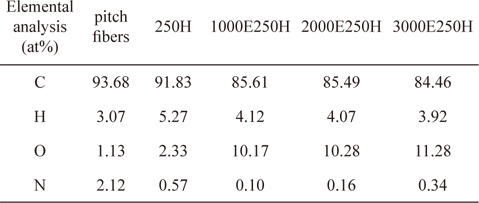
Elemental analysis results of pitch fibers and pitch fibers stabilized under heat treatment after various E-beam conditions
A FT-IR analysis was also conducted to investigate changes in the functional groups of the stabilized fibers, and the results are shown in Fig. 1. After only heat-stabilization at 250℃, the band intensity at 3045, 1598, 1443, and 751 cm-1 increased dramatically, corresponding to the C–H stretching of aromatics, C=C stretching of aromatics, CH2 bending of aromatics, and C–H bending of aromatics (out-of-plane), respectively [16]. A band at 1699 cm-1 was assigned to C=O stretching [17]. This band was observed at 1715 cm-1 for saturated aliphatic ketone and may be shifted to a lower absorption frequency due to delocalized electrons resulting from the presence of C=O in the aromatic group. Another broad band at 3430 cm-1 indicated the hydroxyl stretching of –COOH. These results show that, during the heat stabilization of the pitch fibers, carbonyl and carboxylic groups were introduced and simultaneously form conjugated carbon rings. In the case of the heat-stabilized sample, the CH stretching band of aliphatic at 2922 cm-1 became strong. This increase in intensity was likely due to the decomposition of some of the pitch fibers, particularly the low-molecular-weight fibers, by heat [18]. The increase in the hydrogen content of the heat-stabilized samples was attributed to the same phenomenon. In contrast, the E-beam pretreated pitch fibers showed significant decreases in the intensity of the CH stretching bands and the formation of an additional oxygen functional group (C–O stretching band) at approximately 1262 cm-1. In addition, the band for out-of-plane aromatic C–H bending at 751 cm-1 decreased dramatically, indicating that hydrogen was removed via poly-condensation. It is thus believed that the E-beam irradiation helps the oxidation of pitch fibers and will further improve the mechanical properties of the CFs.
3.2. Evaluation of stabilization
3.2.1. Thermal characteristics
A TGA was conducted to evaluate the thermal characteristics depending on the stabilization conditions. Fig. 2 contains the TG curves for the pitch fibers and the derived heat-treated only and E-beam accompanied stabilized fibers. Fig. 2a shows that the weight changed under a nitrogen atmosphere up to 1000℃ at a heating rate of 10℃/min.
The thermal behavior of the pitch fibers dramatically changed after 450℃, showing a weight change of 25% at 500℃, which indicated the occurrence of dehydrogenation above 250℃ [6]. The thermal behaviors of the stabilized samples were similar to those of the pitch fibers up to approximately 400℃. However, above 400℃, the behaviors became different, suggesting differences in the thermal stability. The weight of the stabilized fibers decreased gradually, and the weight change at 500℃ was only 15%. The increase in weight loss of the pitch fibers was attributed to the inclusion of a low molecular compound [18]. In addition, the weight of the pitch fibers was 0% at slightly above 900℃, which indicated that the pitch had thermally decomposed. The reduced weight changes exhibited by the E-beam-pretreated fibers was attributed to the removal of the remaining oxygen functional groups, such as –OH and –COOH, which formed radicals and then condensed by linking [9,19], as previously shown in Fig. 1. Furthermore, the E-beam-pretreated fibers had a higher carbonization yield at 1000℃ than the fibers only subjected to heat-stabilization. In particular, the carbonization yield of the 3000E250H fibers was 73%. Fig. 2b shows the TGA curves obtained in an air atmosphere, revealing that the stabilized fibers having more oxygen content experienced a weight decrease earlier than the untreated and heat-stabilized only fibers, as the oxygen functionalities decomposed above 250℃, followed by weakening of the bonding structure of the fibers. The derivative of the TGA (dTGA) curves, presented in Fig. 3, shows the degree of weight change based on the peak intensity at a specific temperature. The main peak of the fibers increased with the E-beam treatment severity. The main peak was located at approximately 471℃ for the pitch fibers and the fibers treated at 250℃ and approximately 475℃ for the E-beam-pretreated fibers. In addition, the peak intensity of the heat-treated only fibers was lower for the same temperature. After stabilization accompanying E-beam irradiation, the peak intensity was markedly lower than that of the pitch fibers, with a slight shift toward higher temperatures. This finding indicated that E-beam irradiation facilitated oxygen permeation into the surface and interior of the pitch fibers during oxidation, as the decrease in weight occurred at higher temperature, indicating that melting was prevented [20,21]. These results suggest that E-beam irradiation promotes the condensation polymerization and infusibility of the pitch fibers, which progressed in thermosetting polymers. This improvement is believed to affect the mechanical properties of the fibers after carbonization.
3.2.2. Stabilization level
The stabilization of pitch fibers is a process where the fiber structure progresses gradually into another structure [22]. The structural change during the stabilization can be confirmed by a XRD analysis. From the series of XRD patterns shown in Fig. 4, the change in the peak intensity at a specific 2
where
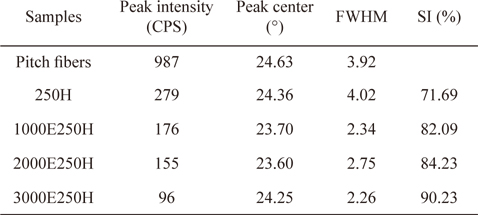
X-ray diffraction parameter data corresponding to the pitch fibers and the pitch fibers stabilized under heat treatment with various E-beam conditions
From the XRD study of stabilized fibers, the pitch fibers showed a peak at a specific 2θ (approximately 26°), which is different from PAN fibers (approximately 16°) [22,23], and the intensity of the peaks also varied depending on the stabilization conditions. This explains why the synthetic mechanism and structural change of the pitch fibers are slightly different from those of the PAN fiber after heat treatment. This indicates that the pitch fibers also undergo structural change during stabilization, even though the aromatic compounds of the pitch fiber grew differently from cyclization of the PAN fibers. Furthermore, the mechanical properties of the pitch fibers were consistent with the results of SI calculated from the XRD analysis. This effect is thus likely also manifested in the pitch fibers.
As shown in Fig. 4, the peak intensity at approximately 26° decreased after stabilization using heat and E-beam irradiation. Although the fiber that was heat-stabilized only showed a large decrease in the peak intensity, the fibers treated with E-beam irradiation showed even greater decreases. In addition, a larger decrease in the peak intensity was observed with increasing adsorbed dose. This was attributed to the excellent stabilization of the pitch fibers.
Comparing the SI depending on the stabilization conditions in Table 2, the 250H fibers had an SI of 71.69%. As shown in Fig. 4, the SI increased with increasing adsorbed dose, and the SIs for the 1000E250H, 2000E250H, and 3000E250H fibers were 82.09%, 84.23%, and 90.23%, respectively. We also tested the stabilization using only 3000 kGy under the same conditions, and the resulting SI was 47.87%. The calculated SI results were in accordance with the TGA and dTGA results.
3.3. Mechanical properties after carbonization
The fibers irradiated at only 3000 kGy melted after carbonization at 1000℃ for 1 h in a furnace, indicating that the stabilization was not successful. E-beam irradiation alone could not achieve perfect stabilization. However, heat-treatment after E-beam irradiation increased the tensile strength and Young’s modulus. The tensile strength was 0.22, 0.35, 0.51, and 0.54 GPa for the 250H, 1000E250H, 2000E250H, and 3000E250H fibers, respectively (Fig. 5). The Young’s moduli were 26.5, 45.9, 50.9, and 70.2 GPa for the250H, 1000E250H, 2000E250H, and 3000E250H fibers, respectively. These tensile strengths above 500 MPa are comparable to the values of general purpose CFs derived from isotropic pitches [24,25]. The CFs prepared using E-beam irradiation achieved tensile strength on par with that of general purpose CFs obtained from pitch. The mechanical properties of the samples increased with increasing absorbed E-beam radiation dose, indicating that an increase in absorbed dose gradually improved the coherence of the carbonized fibers. The elongation thus decreased, significantly increasing the Young’s modulus from 2000 to 3000 kGy. The 250H fibers were stabilized with an SI of 71.69% SI; however, the tensile strength was only 0.22 GPa. E-beam irradiation was thus an efficient way to stabilize the pitch fibers if followed by heat-treatment. In this study, oxidation and polymerization proceeded when the SI was above approximately 70% and did not proceed when the SI was lower than 50%. Fig. 6a-d show cross-sectional images of the CFs after carbonization at 1000℃. The cross-sectional images exhibited similar fiber diameters (17-18 μm).
CFs were prepared through a stabilization process using E-beam irradiation followed by heat-treatment. The EA and FT-IR results showed that the fibers subjected to E-beam irradiation had high oxygen content, a weak C–H stretching band, and the presence of C–O groups as well as carbonyl and carboxylic groups compared to the fibers prepared without E-beam irradiation. The thermal resistance of the E-beam pretreated fibers increased, with TGA and dTGA results indicating smaller weight losses at the same temperature. These results were attributed to a higher SI obtained from E-beam treatment. The stabilization process accompanied by E-beam irradiation demonstrated that the use of the E-beam as a supplemental agent helped the pitch fibers transform into thermosetting polymers by oxidation and dehydrogenation. Furthermore, this process affected the mechanical properties of the CFs, as the fibers treated with an absorbed dose of 3000 kGy showed the highest tensile strength, 0.54 GPa, in this study.


